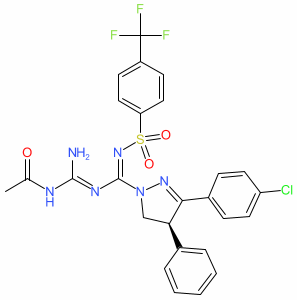GtoPdb is requesting financial support from commercial users. Please see our sustainability page for more information.
|
Synonyms: (S)-MRI-1891 | INV-202 | MRI-1891
Compound class:
Synthetic organic
Comment: Monlunabant (INV-202; MRI-1891) is a peripherally acting cannabinoid CB1 receptor inverse agonist [2,4-5]. Structurally it is a derivative of ibipinabant that has been modified to prevent the molecule from penetrating the blood-brain barrier. Bias towards β-arrestin-2 recruitment over G protein signalling has been claimed [5].
Ligand Activity Visualisation ChartsThese are box plot that provide a unique visualisation, summarising all the activity data for a ligand taken from ChEMBL and GtoPdb across multiple targets and species. Click on a plot to see the median, interquartile range, low and high data points. A value of zero indicates that no data are available. A separate chart is created for each target, and where possible the algorithm tries to merge ChEMBL and GtoPdb targets by matching them on name and UniProt accession, for each available species. However, please note that inconsistency in naming of targets may lead to data for the same target being reported across multiple charts. ✖ |
|
|||||||||||||||||||||||||||||||||||
| References |
|
1. Crater GD, Lalonde K, Ravenelle F, Harvey M, Després JP. (2024)
Effects of CB1R inverse agonist, INV-202, in patients with features of metabolic syndrome. A randomized, placebo-controlled, double-blind phase 1b study. Diabetes Obes Metab, 26 (2): 642-649. [PMID:37941317] |
|
2. Ghosh A, Peyot ML, Leung YH, Ravenelle F, Madiraju SRM, Prentki M. (2023)
A peripherally restricted cannabinoid-1 receptor inverse agonist promotes insulin secretion and protects from cytokine toxicity in human pancreatic islets. Eur J Pharmacol, 944: 175589. [PMID:36773683] |
|
3. Jacquot L, Pointeau O, Roger-Villeboeuf C, Passilly-Degrace P, Belkaid R, Regazzoni I, Leemput J, Buch C, Demizieux L, Vergès B et al.. (2023)
Therapeutic potential of a novel peripherally restricted CB1R inverse agonist on the progression of diabetic nephropathy. Front Nephrol, 3: 1138416. [PMID:37675364] |
|
4. Kumari P, Dvorácskó S, Enos MD, Ramesh K, Lim D, Hassan SA, Kunos G, Cinar R, Iyer MR, Rosenbaum DM. (2024)
Structural mechanism of CB1R binding to peripheral and biased inverse agonists. Nat Commun, 15 (1): 10694. [PMID:39695122] |
|
5. Liu Z, Iyer MR, Godlewski G, Jourdan T, Liu J, Coffey NJ, Zawatsky CN, Puhl HL, Wess J, Meister J et al.. (2021)
Functional Selectivity of a Biased Cannabinoid-1 Receptor (CB1R) Antagonist. ACS Pharmacol Transl Sci, 4 (3): 1175-1187. [PMID:34151207] |







